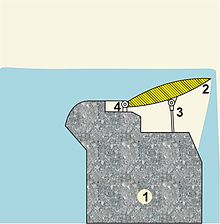Fish belly flap
Fish-bellied flaps are movable segments of a weir , which are often mounted in a hinge-like manner on a weir sleeper. By means of fish belly flaps, a very precise upper water level is achieved in dams, which can be quickly regulated.
construction
Fish belly valves were first used around 1930. They are a further development of the previously common sector flaps and are characterized by high torsional stiffness with a significantly reduced steel volume . The flaps are usually closed as a hollow body, whereby the buoyancy in the water considerably reduces the actuating forces required for closing. Since they are often operated with one-sided drive in smaller systems and the flap must still be able to move safely in larger systems with a drive on both sides if one drive fails, the torsional rigidity and buoyancy as well as the weight reduction are of great importance. The special shape shows in the profile two circular segments combined at the secant . In some versions, additional stages are provided. In addition to their curved or stepped shape, fish-bellied flaps usually have stiffening plates welded in on the inside, similar to a ship's hull.
function
The adjacent graphic Simple representation of a fish- bellied flap in the closed state shows a fish- bellied flap (2) with a central hydraulic drive (3) mounted on a concrete weir sleeper (1). The associated hydraulic cylinder is located in the body of the weir, protected against water, ice and floating debris. The flap is closed in this position, the maximum stowage destination can be reached.
By retracting the piston rod, see graphic fish-bellied flap open , the flap is lowered around its fixed pivot point (4) and can be overflown by the pent-up water. The water level is lowered and adapts to the new height level.
Vibration behavior
Due to the shape of the valve (curvature), depending on the position of the valve and the flow of the overflow, fish-bellied valves are highly susceptible to vibrations; this behavior must be taken into account when designing the valve, similar to bridge construction. In larger systems, the flaps are also ventilated from the underside in order to avoid vortex formation. Another measure to reduce unwanted vibrations is to place jet disruptors or jet rippers on the overflow edge in order to tear open the falling water band.
photos
Fish belly flap at the Weser weir in Bremen
Fish-bellied flap at the Perlenbachtalsperre
Fish-bellied flap on the Obermaubach reservoir
Individual evidence
- ↑ www.hollow-cubes.de, Repetitorium dam construction (PDF; 135 kB)






